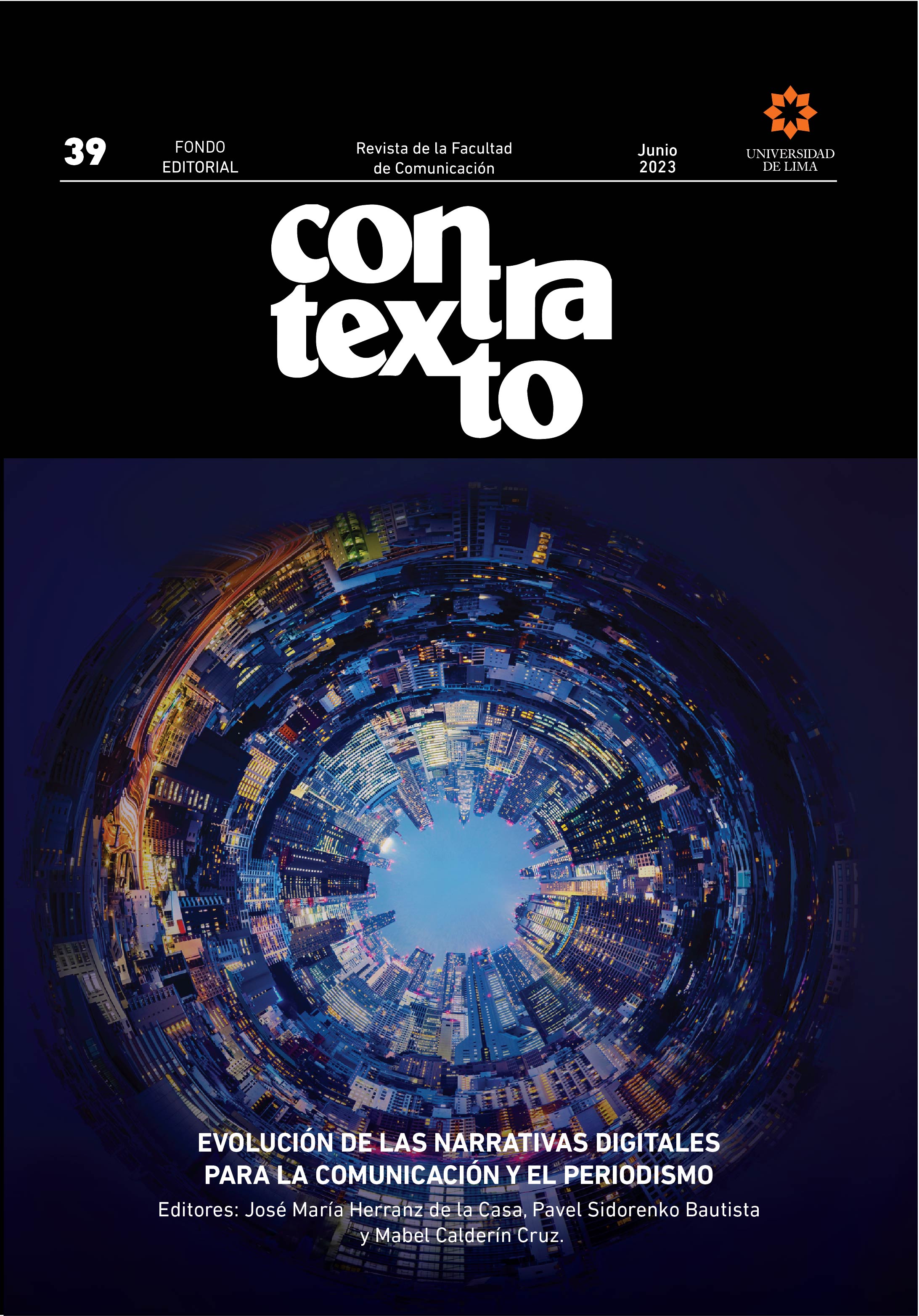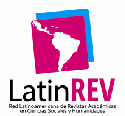Noticias falsas: dónde se encuentran periodistas y audiencias (y dónde no)
DOI:
https://doi.org/10.26439/contratexto2023.n39.5623Palabras clave:
audiencias, noticias falsas, periodismo, redes socialesResumen
Este artículo les da voz a dos protagonistas del fenómeno de la desinformación: las audiencias y los periodistas. Se presenta un análisis comparativo que tiene dos objetivos: por un lado, explorar el papel de las audiencias en la dinamización del fenómeno de la desinformación en Costa Rica y caracterizar las dinámicas que las mismas establecen con las noticias falsas que se difunden en el país y, por otro lado, darles voz a periodistas para contraponer y comparar sus percepciones con las de sus audiencias. Se aplicó una metodología cualitativa basada en entrevistas semiestructuradas a una muestra pequeña y no representativa de periodistas costarricenses en puestos de mando de algunos de los principales medios del país y se realizaron seis grupos de discusión con audiencias. El artículo hace un análisis comparativo sobre lo que piensan los profesionales en periodismo y las audiencias participantes sobre el fenómeno de la desinformación, la idea de noticias falsas, las responsabilidades en la lucha contra esta problemática y cuáles soluciones ven viables. Los resultados sugieren que, para los periodistas, los contenidos desinformativos son los que circulan en redes sociales y no son contenidos de los medios tradicionales que representan; en cambio, en las audiencias se evidencia una postura antagónica, pues, por un lado, tienden a asociar la desinformación con la labor de los medios tradicionales; no obstante, por otro lado, también los mencionan como fuente de verificación frente a los contenidos falsos que circulan en redes sociales.
Descargas
Referencias
Allcott, H., & Gentzkow, M. (2017). Social media and fake news in the 2016 election. Journal of Economic Perspectives, 31(2), 211-236. http://doi.org/10.1257/jep.31.2.211
Alemanno, A. (2018). How to counter fake news? A taxonomy of antifake news approaches. European journal of risk regulation, 9(1), 1-5.
Alonso, P. (2017). ‘Fake news’ y posverdad en tiempos de populismos: lecciones para periodistas. Cuadernos de periodistas: revista de la Asociación de la Prensa de Madrid, (34), 77-84. https://www.cuadernosdeperiodistas.com/fake-news-posverdad-tiempos-populismos-lecciones-periodistas/
Auerbach, C. F., & Silverstein, L. B. (2003). Qualitative data: an introduction to coding and analysis. New York University Press.
Bakir, V., & McStay, A. (2018). Fake news and the economy of emotions. Digital Journalism, 6(2), 154-175. https://doi.org/10.1080/21670811.2017.1345645
Beer, D. (2017). The social power of algorithms. Information, Communication & Society, 20(1), 1-13. https://doi.org/10.1080/1369118X.2016.1216147
Blanco, I., García, C., & Tejedor, S. (2019). El impacto de las fake news en la investigación en Ciencias Sociales. Revisión bibliográfica sistematizada. Historia y Comunicación Social, 24(2), 449-469. https://doi.org/10.5209/hics.66290
Brandtzaeg, P. B., & Følstad, A. (2017). Trust and distrust in online fact-checking services. Communications of the ACM, 60(9), 65-71. https://doi.org/10.1145/3122803
Brenan, M., & Stubbs, H. (2020). News media viewed as biased but crucial to democracy. Gallup. https://news.gallup.com/poll/316574/news-media-viewed-biased-crucial-democracy.aspx
Campos-Freire, F., Rúas-Araújo, J., López-García, X., & Martínez-Fernández, V.-A. (2016). Impacto de las redes sociales en el periodismo. Profesional de la Información, 25(3), 449-457. https://doi.org/10.3145/epi.2016.may.15
Canales, M., & Peinado, A. (1994). Grupos de discusión. In J. M. Delgado & J. Gutiérrez (Eds.), Métodos y Técnicas Cualitativas de Investigación en Ciencias Sociales (pp. 287-316). Editorial Síntesis.
Carazo-Barrantes, C., Tristán Jiménez, L., & Siles González, I. (2021). Noticias falsas y desinformación en Costa Rica: hacia una agenda de investigación. In I. Siles
González, L. Tristán Jiménez & C. Carazo Barrantes (Eds.), Verdad en extinción: miradas interdisciplinarias a la desinformación en Costa Rica, (pp. 3-44). Centro de Investigación en Comunicación (CICOM); Universidad de Costa Rica. https://www.kerwa.ucr.ac.cr/bitstream/handle/10669/85599/Siles_Tristan_Carazo_Verdad_en_extincio%cc%81n_2021.pdf?sequence=1&isAllowed=y
Carlson, M. (2018a). Facebook in the news. Social media, journalism, and public responsibility following the 2016 trending topics controversy. Digital Journalism, 6(1), 4-20. https://doi.org/10.1080/21670811.2017.1298044
Carlson, M. (2018b). The information politics of journalism in a post-truth age. Journalism Studies, 19(13), 1879-1888. http://dx.doi.org/10.1080/1461670X.2018.1494513
Davison, W. P. (1983). The third-person effect in communication. Public Opinion Quarterly, 47(1), 1-5. https://doi.org/10.1086/268763
Echevarría, B. (2016). Más ‘fact-checking’ contra la posverdad. Cuadernos de periodistas, (33), 9-16. https://www.cuadernosdeperiodistas.com/mas-fact-checking-la-posverdad/
Egelhofer, J. L., & Lecheler, S. (2019). Fake news as a two-dimensional phenomenon: a framework and research agenda. Annals of the International Communication Association, 43(2), 97-116. https://doi.org/10.1080/23808985.2019.1602782
Figueras-Maz, M., Mauri-Ríos, M., Alsius-Clavera, S., & Salgado-De-Dios, F. (2012). La precariedad te hace dócil. Problemas que afectan a la profesión periodística. Profesional de la Información, 21(1), 70-75. https://doi.org/10.3145/epi.2012.ene.09
Fletcher, R., Cornia, A., Graves, L., & Nielsen, R. K. (2018). Measuring the reach of "fake news” and online disinformation in Europe. Australasian Policing, 10(2).
França, F. F., Costa, M. L. F., & Santos, R. O. D. (2019). As novas tecnologias digitais de informação e comunicação no contexto educacional das políticas públicas: possibilidades de luta e resistência. ETD Educação Temática Digital, 21(3), 645-661. https://doi.org/10.20396/etd.v21i3.8654687
Grinberg, N., Joseph, K., Friedland, L., Swire-Thompson, B., & Lazer, D. (2019). Fake news on Twitter during the 2016 U.S. presidential election. Science, 363(6425), 374-378. https://doi.org/10.1126/science.aau2706
Guess, A., Nagler, J., & Tucker, J. (2019). Less than you think: prevalence and predictors of fake news dissemination on Facebook. Science Advances, 5(1). https://doi.org/10.1126/sciadv.aau4586
Hedman, U. (2015). J-Tweeters: pointing towards a new set of professional practices and norms in journalism. Digital Journalism, 3(2), 279-297. https://doi.org/10.1080/21670811.2014.897833
Jang, S. M., & Kim, J. K. (2017). Third person effect of fake news: fake news regulation and media literacy interventions. Computers in Human Behavior, 80, 295-302. http://dx.doi.org/10.1016/j.chb.2017.11.034
Klapper, J. T. (1957). What we know about the effects of mass communication: the brink of hope. Public opinion quarterly, 21(4), 453-474. https://www.jstor.org/stable/2746759
Klein, D. O., & Wueller, J. R. (2017). Fake news: a legal perspective. Australasian Policing, 10(2). https://ssrn.com/abstract=2958790
Kovach, B., & Rosenstiel, T. (2012). Los elementos del periodismo. Aguilar.
Lawson, M. A., & Kakkar, H. (2020). Of pandemics, politics, and personality: the role of conscientiousness and political ideology in sharing of fake news. Journal of Experimental Psychology: General, 151(5), 1154. https://doi.org/10.31234/osf.io/ves5m
Lazer, D., Baum, M., Benkler, Y., Berinsky, A., Greenhill, K., Menczer, F. M., Nyhan, B., Pennycook, G., Rothschild, D., Schudson, M., Sloman, S., Sunstein, C., Thorson, E., Watts, D., & Zittrain, J. (2018). The science of fake news. Science, 359 (6380), 1094-1096. https://doi.org/10.1126/science.aao2998
Lecheler, S., & Egelhofer, J. L. (2020). Consumption of misinformation and disinformation. In H. Tumber & S. Waisbord (Eds.), The Routledge companion to media disinformation and populism (pp. 323-331). Routledge. https://doi.org/10.4324/9781003004431
Lotero-Echeverri, G., Romero-Rodríguez, L. M., & Pérez-Rodríguez, M. A. (2018). ‘Factchecking’ vs. ‘fake news’: periodismo de confirmación como recurso de la competencia mediática contra la desinformación. Index. Comunicación, 8(2), 295-316. http://rabida.uhu.es/dspace/bitstream/10272/16180/2/Fact-checking.pdf
Lunt, P., & Livingstone, S. (1996). Rethinking the focus group in media and communications research. Journal of Communication, 46(2), 79-98. http://dx.doi.org/10.1111/j.1460-2466.1996.tb01475.x
Manor, I. (2019). The specter of echo chambers—Public diplomacy in the age of disinformation. In The Digitalization of Public Diplomacy. Palgrave Macmillan Series in Global Public Diplomacy (pp. 135-176). Palgrave Macmillan; Cham. https://doi.org/10.1007/978-3-030-04405-3_5
Marchi, R. (2012). With Facebook, blogs, and fake news, teens reject journalistic “objectivity". Journal of Communication Inquiry, 36(3), 246-262. https://doi.org/10.1177/0196859912458700
Martens, B., Aguiar, L., Gómez-Herrera, E., & Mueller-Langer, F. (2018). The digital transformation of news media and the rise of disinformation and fake news. Digital Economy Working Paper 2018-02, Joint Research Centre Technical Reports. https://doi.org/10.2139/ssrn.3164170
McGrew, S., Breakstone, J., Ortega, T., Smith, M., & Wineburg, S. (2018). Can students evaluate online sources? Learning from assessments of civic online reasoning. Theory & Research in Social Education, 46(2), 165-193, https://doi.org/10.1080/00933104.2017.1416320
Metag, J., & Rauchfleisch, A. (2017). Journalists’ use of political tweets: functions for journalistic work and the role of perceived influences. Digital Journalism, 5(9), 1155-1172. https://doi.org/10.1080/21670811.2016.1248989
Metzger, M. J., Flanagin, A. J., & Zwarun, L. (2003). College student web use, perceptions of information credibility, and verification behavior. Computers & Education, 41(3), 271-290. https://doi.org/10.1016/S0360-1315(03)00049-6
Middaugh, E. (2018). Civic media literacy in a transmedia world: balancing personal experience, factual accuracy and emotional appeal as media consumers and circulators. Journal of Media Literacy Education, 10(2), 33-52. https://doi.org/10.23860/JMLE-2018-10-2-3
Middaugh, E. (2019). More than just facts: promoting civic media literacy in the era of outrage. Peabody Journal of Education, 94(1), 17-31. http://dx.doi.org/10.1080/0161956X.2019.1553582
Miles, M. B., Huberman, A. M., & Saldana, J. (2014). Qualitative data analysis: a methods sourcebook. Sage.
Mourão, R. R., & Robertson, C. T. (2019). Fake news as discursive integration: an analysis of sites that publish false, misleading, hyperpartisan and sensational information. Journalism studies, 20(14), 2077-2095. https://doi.org/10.1080/1461670X.2019.1566871
Munger, K. (2020). All the news that’s fit to click: the economics of clickbait media. Political Communication, 37(3), 376-397. https://doi.org/10.1080/10584609.2019.1687626
Musgrove, A., Powers, J., Rebar, L., & Musgrove, G. (2018). Real o fake? Resources for teaching college students how to identify fake news. Collegue & Undergraduate Libraries, 25(3), 243-260. https://doi.org/10.1080/10691316.2018.1480444
Nelson, J. L., & Taneja, H. (2018). The small, disloyal fake news audience: the role of audience availability in fake news consumption. New Media & Society, 20(10) 3720-3737. http://dx.doi.org/10.1177/1461444818758715
Pangrazio, L. (2018). What’s new about ‘fake news’? Critical digital literacies in an era of fake news, post-truth and clickbait. Páginas de Educación, 11(1), 6-22. http://dx.doi.org/10.22235/pe.v11i1.1551
Pariser, E. (2011). The filter bubble: how the new personalized web is changing what we read and how we think. Penguin Books.
Parra-Valero. P., & Oliveira, L. (2018). Fake news: una revisión sistemática de la literatura (Fake news: a systematic review of the literatura). Observatorio (OBS*), 12(5), 54-78. https://doi.org/10.15847/obsOBS12520181374
Pérez Tornero, J. M., Samy Tayie, S., Tejedor, S., & Pulido, C. (2018). ¿Cómo afrontar las noticias falseadas mediante la alfabetización periodística? Estado de la cuestión. Doxa Comunicación. Revista Interdisciplinar de Estudios de Comunicación y Ciencias Sociales, (26), 211-235. http://dx.doi.org/10.31921/doxacom.n26a10
Rodrigo Alsina, M. (2005). La construcción de la noticia. Paidós.
Rodríguez-Pérez, C. (2019). No diga fake news, di desinformación: una revisión sobre el fenómeno de las noticias falsas y sus implicaciones. Comunicación, (40), 65-74
Romero-Rodríguez, L. M., Contreras-Pulido, P., & Pérez-Rodríguez, M. A. (2019). Las competencias mediáticas de profesores y estudiantes universitarios. Comparación de niveles en España, Portugal, Brasil y Venezuela. Culture and Education, 31(2), 346-368. https://doi.org/10.1080/11356405.2019.1597564
Saldaña, J. (2009). The coding manual for qualitative researchers. Sage.
Salgado, S. (2021). Disputes over or against reality?: fine-graining the textures of posttruth politics. In The Routledge Companion to Media Disinformation and Populism (pp. 101-109). Routledge
Sánchez, M., & Fuente, C. (2020). Periodismo vs desinformación: la función social del periodista profesional en la era de las fake news y la posverdad. Sintaxis, 1(4), 1-18. https://doi.org/10.36105/stx.2020n4.01
Shao, C., Ciampaglia, G. L., Varol, O., Yang, K. C., Flammini, A., & Menczer, F. (2018). The spread of low-credibility content by social bots. Nature communications, 9(1), 1-9.
https://doi.org/10.1038/s41467-018-06930-7
Siles, I., & Boczkowski, P. J. (2012). Making sense of the newspaper crisis: a critical assessment of existing research and an agenda for future work. New Media & Society, 14(8), 1375-1394. https://doi.org/10.1177/1461444812455148
Suárez-Villegas, J. C., & Cruz Álvarez, J. (2016). Los dilemas deontológicos del uso de las redes sociales como fuentes de información. Análisis de la opinión de los periodistas de tres países. Revista Latina de Comunicación Social, (71), 66-84. https://doi.org/10.4185/RLCS-2016-1084
Tandoc, E. C., Ling, R., Westlund, O., Duffy, A., Goh, D., & Zheng Wei, L. (2018). Audiences’ acts of authentication in the age of fake news: a conceptual framework. New Media & Society, 20(8), 2745-2763. https://doi.org/10.1177/1461444817731756
Terol-Bolinches, R., & Alonso-López, N. (2020). La prensa española en la era de la posverdad: el compromiso de la verificación de datos para combatir las fake news. Prisma Social: revista de investigación social, (31), 304-327.
Tong, J. (2018). Journalistic legitimacy revisited: collapse or revival in the digital age? Digital Journalism, 6(2), 256-273. https://doi.org/10.1080/21670811.2017.1360785
Vargo, C. J., Guo, L., & Amazeen, M. A. (2018). The agenda-setting power of fake news: a big data analysis of the online media landscape from 2014 to 2016. New Media & Society, 20(5), 2028-2049. https://doi.org/10.1177/1461444817712086
Vázquez-Herrero, J., Direito-Rebollal, S., & López-García, X. (2019). Ephemeral journalism:news distribution through Instagram stories. Social Media + Society, 5(4). https://doi.org/10.1177/2056305119888657
Vosoughi, S., Roy, D., & Aral, S. (2018). The spread of true and false news online. Science, 359(6380), 1146-1151. https://doi.org/10.1126/science.aap9559
Descargas
Publicado
Número
Sección
Licencia
Todos los trabajos publicados están sujetos a una licencia CC BY 4.0 Creative Commons (actualizado el 1 de marzo de 2021).
El contenido de la revista se puede compartir en cualquier material o formato. Asimismo, se puede adaptar, contribuir y transformar. Ambas posibilidades sólo están permitidas en la medida en que cumplan las siguientes condiciones:
- Atribución: Se debe otorgar crédito donde sea debido, proporcionar un enlace a la licencia e indicar los cambios en caso se realice alguno. Esto debe hacerse de la manera que se considere apropiada, sin sugerir que el licenciante lo promueva a usted o su uso del material.
Derechos de propiedad
Los derechos patrimoniales de Contratexto se publican bajo una licencia Creative Commons BY 4.0, lo que permite a los autores mantener los derechos patrimoniales de su obra sin restricciones.
Si un trabajo publicado en Contratexto fuera copiado, distribuido, difundido o cualquier otra actividad contemplada en la licencia antes mencionada, se deberá mencionar de manera visible y expresa al autor o autores y a la revista.
Auto-archivo
Esta revista permite y anima a los autores/as a publicar artículos enviados a la revista en sus sitios web personales o en depósitos institucionales, tanto antes como después de su publicación en esta revista, siempre y cuando proporcionen información bibliográfica que acredite, si procede, su publicación en ella.


















